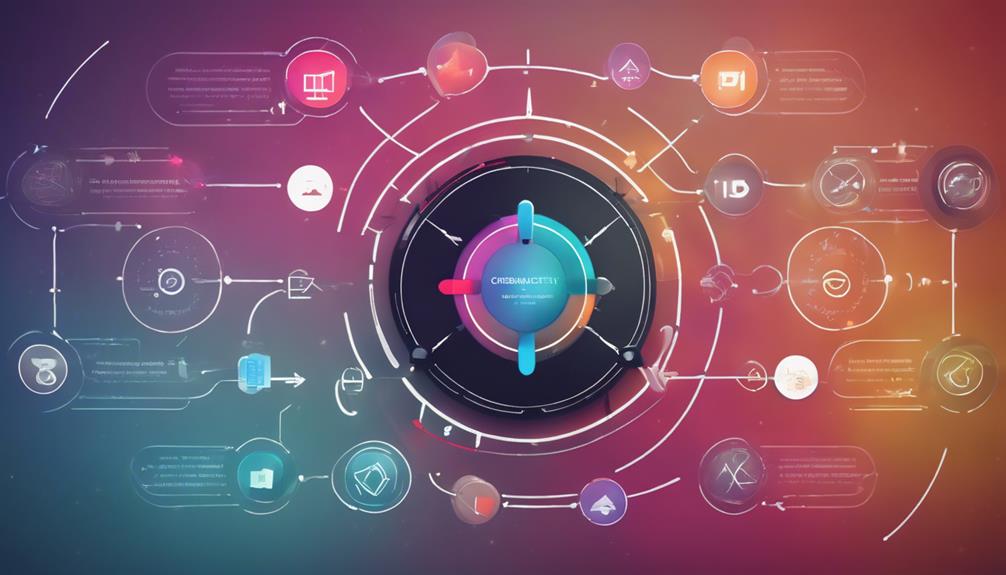To create your first automated workflow, I start by defining specific tasks for automation and identifying triggers, actions, and bottlenecks. I then pinpoint key actors and their roles, guaranteeing seamless integration. Next, I choose the right tools, leveraging software and templates, and thoroughly map data sources and flows. I detail handoff points and stakeholders for smooth handovers. Designing a workflow diagram, I lay out inputs, outputs, dependencies, and decision points. Testing ensures accuracy, followed by training the team. Finally, I deploy and continuously monitor for inefficiencies. There's more detail that could refine your process even further.
Key Takeaways
- Define specific tasks for automation, including triggers, actions, and desired outcomes.
- Identify and integrate relevant data sources to ensure seamless data flow.
- Utilize workflow automation tools and templates to streamline the design process.
- Design a workflow diagram outlining inputs, outputs, dependencies, and decision points.
- Test the workflow thoroughly and provide training to key actors for effective implementation.
Define Your Workflow
To define your automated workflow, begin by identifying the specific tasks that require automation. Pinpointing these tasks helps in setting clear starting and ending points for your workflow, ensuring we meet our objectives efficiently.
Next, examine the triggers and actions essential for your process. For instance, an email receipt could be a trigger that initiates a series of automated actions like data extraction and entry into a database. By systematically listing all potential input sources, such as forms, emails, or specific events, we can map out a thorough workflow.
Additionally, it's important to identify potential bottlenecks or handoffs that might disrupt the process, allowing us to design a seamless and innovative automated workflow.
Identify Key Actors
Having mapped out the workflow, we now need to identify the key actors who'll interact with and influence the automation process. These actors can be team members, departments, or even external stakeholders. Each key actor plays an essential role and their responsibilities must be clearly defined to guarantee a smooth automation process.
Understanding the contributions and levels of involvement of these actors is vital for designing an effective automated workflow. By systematically defining their roles and responsibilities, we can streamline the automation process and mitigate potential bottlenecks.
This detailed approach ensures that each actor knows their tasks and how they fit into the broader workflow, driving innovation and efficiency.
List Necessary Tools

Selecting the right tools is essential for creating an efficient and effective automated workflow. First, I need robust workflow automation software like HubSpot, which offers access to templates and a workflow builder. Integration capabilities are critical for seamless workflow management with other systems. Customizable forms, conditional logic, and rules enhance functionality. Access to a data panel will simplify data management and streamline object source access.
Here's a breakdown of necessary tools:
| Tool | Purpose | Importance |
|---|---|---|
| Workflow Automation Software | Create and manage workflows | Central to workflow setup |
| Templates | Predefined workflow structures | Speeds up creation process |
| Integration Capabilities | Connect with other systems | Ensures smooth operations |
| Data Panel | Manage and access data | Vital for data-driven decisions |
Map Input Avenues
To effectively map input avenues, I start by identifying all data sources, such as forms, emails, and databases.
Then, I analyze the data flow from these sources to understand how information enters and moves through the system.
This systematic approach guarantees no data gaps, making the automation process seamless and efficient.
Identify Data Sources
When identifying data sources, pinpointing every input avenue like forms, emails, and databases is essential for mapping the start and end points of your automated workflow.
Each data source serves as an important entry point, dictating how and where data flows into the system. To guarantee thorough coverage, I meticulously list all potential input avenues. This includes online forms, email submissions, and integrated databases.
By doing so, I can clearly map out the entire automated workflow process. Understanding these input avenues not only streamlines data flow but also enhances process efficiency.
It's essential to capture every channel through which data is collected to avoid bottlenecks and ensure a seamless automation experience.
Analyze Data Flow
With all data sources identified, the next step involves systematically analyzing the data flow to understand how information travels through the automated workflow. By mapping input avenues, I gain insight into where data originates and how it seamlessly integrates into the system. This step is vital for designing an efficient workflow automation process.
Here's what I focus on:
- Forms: Data collected from user submissions.
- Emails: Information extracted from email communications.
- Data sources: Databases and third-party applications feeding data into the workflow.
Analyzing these input avenues ensures I capture all possible entry points, leading to a thorough automation solution. Understanding the data flow allows me to design a seamless, innovative automated workflow that handles data effectively and efficiently.
Detail Handoff Points

Now, let's focus on detail handoff points, which are critical for maintaining workflow efficiency.
I'll start by establishing handoff criteria to guarantee tasks are transferred seamlessly.
Then, I'll identify key stakeholders and optimize communication channels to enhance coordination.
Define Handoff Criteria
Establishing specific handoff points within your workflow is essential for ensuring tasks shift smoothly from one team to another. To define effective handoff criteria, I focus on a systematic, detail-oriented approach that boosts workflow efficiency.
First, identify critical switch points where tasks change hands. Common triggers include:
- Completion of a specific task
- Reaching a milestone
- A change in status
Next, clearly outline the responsibilities and expectations at each switch point to guarantee a seamless handover. Consider automating handoffs by setting up notifications or triggers based on predefined conditions. This not only streamlines the workflow but also minimizes human error.
Regularly review and update these criteria to keep pace with evolving business needs, ensuring your workflow remains efficient and innovative.
Identify Key Stakeholders
How can we guarantee that each task moves smoothly? First, we need to identify key stakeholders involved in the workflow, understanding their specific roles and responsibilities. This clarity ensures everyone knows what's expected of them.
Next, we'll detail handoff points—critical junctures where tasks shift between stakeholders. By defining these handoff points, we can pinpoint where potential bottlenecks might occur and streamline the process.
Alongside this, automating handoff points can significantly reduce manual errors and speed up task shifts. Essentially, by meticulously detailing roles and responsibilities and focusing on clear, automated handoff points, we create a seamless workflow that's both efficient and innovative.
This systematic approach is essential for achieving a highly functional automated workflow.
Optimize Communication Channels
To optimize communication channels, we must pinpoint the exact handoff points where tasks shift between stakeholders. Identifying these critical junctures allows us to automate communication processes effectively, guaranteeing seamless shifts.
Here's how to detail handoff points systematically:
- Integrate tools: Use software to automate communication processes, minimizing manual errors.
- Define triggers: Establish specific actions that signal when communication handoffs should occur.
- Set clear guidelines: Develop protocols to make sure that communication handoffs are timely and precise.
Create Automation Wishlist
Identifying specific tasks or processes for automation is the first step in creating an effective automation wishlist. I'll begin by pinpointing tasks that are repetitive and time-consuming. Next, I'll prioritize my automation goals based on efficiency gains, time savings, or error reduction. Evaluating task importance is vital to assess the impact of automation. I'll also consider task complexity to select the right automation tool. Finally, I'll create a detailed wishlist outlining the desired outcomes and benefits for each task.
Here's a sample wishlist:
| Task | Frequency | Desired Outcomes |
|---|---|---|
| Data Entry | Daily | Error Reduction, Time Savings |
| Email Responses | Hourly | Efficiency Gains |
| Report Generation | Weekly | Time Savings, Consistency |
| Invoice Processing | Monthly | Error Reduction, Efficiency |
| Social Media Posting | Daily | Time Savings, Engagement Boost |
Design Workflow Diagram

When I start designing a workflow diagram, I first identify key processes to understand what needs automation.
Next, I define each workflow step in detail to map out the sequence of tasks and decisions.
This helps me optimize the task sequence, ensuring the workflow is efficient and free of bottlenecks.
Identify Key Processes
As we begin identifying key processes, let's start by listing out the essential tasks, roles, and sequences that will form the backbone of our workflow.
To design an effective workflow diagram, we'll focus on:
- Tasks: Break down complex operations into manageable, actionable steps.
- Roles: Define who's responsible for each task to guarantee accountability.
- Sequences: Map the order of operations to establish a logical flow.
Define Workflow Steps
Let's explore defining the workflow steps by carefully outlining each specific task and action required to complete the process.
First, I map out the entire business process to identify all the necessary tasks.
I then design a workflow diagram to visually represent the sequence of steps in the automated workflow. Each step should be clearly defined with inputs, outputs, and dependencies.
I incorporate decision points, branches, and triggers to make sure of clarity.
This systematic approach helps visualize the automation process, making it easier to identify potential improvements.
Crafting a detailed workflow diagram is essential for anyone looking to effectively automate workflows, as it provides a clear roadmap for seamless execution and efficiency enhancements.
Optimize Task Sequence
To optimize task sequences in your workflow diagram, I systematically identify dependencies, parallel processes, and feedback loops to enhance efficiency and clarity.
When I create a workflow diagram, I focus on visually mapping out tasks, approvals, and notifications using symbols and arrows. This helps me streamline processes and guarantee smooth automation.
By pinpointing dependencies, I can:
- Identify bottlenecks: Recognize tasks that could delay the workflow.
- Parallel processes: Run tasks concurrently to save time.
- Feedback loops: Implement iterative checks to refine processes.
Each step, action, and automation trigger is clearly illustrated, making the workflow diagram an invaluable tool for optimizing task sequences. This meticulous approach ensures that the automation implementation is both efficient and effective, driving innovation forward.
Test the Workflow
Consistently test the workflow by enrolling test contacts to validate that every action triggers correctly and at the right intervals.
I start by verifying that emails are dispatched according to the designed schedule. Each step in the process must be scrutinized for errors; if something goes wrong, I troubleshoot immediately.
I also confirm that contacts move seamlessly through the workflow stages, guaranteeing no one gets stuck or misplaced.
Based on the test results, I make necessary adjustments to optimize performance. This systematic approach guarantees that the workflow operates flawlessly, delivering a polished and efficient automation experience.
Innovation thrives on precision, and rigorous testing is the key to achieving a reliable automated workflow.
Train Your Team

Training your team on automated workflows is pivotal to maximizing efficiency and productivity across the organization. I initiate this by conducting hands-on training sessions, focusing on the practical use of workflow automation tools. During these sessions, I guarantee everyone understands the benefits and the ins and outs of the processes involved.
To reinforce learning, I provide various resources:
- Tutorials that walk through each step.
- Detailed guides for thorough understanding.
- FAQs addressing common concerns.
I encourage team members to ask questions, seek clarification, and offer feedback. Monitoring progress and providing ongoing support ensures continuous improvement.
Deploy and Optimize
After deploying the automated workflow, I immediately begin monitoring its performance to pinpoint any bottlenecks or inefficiencies. Utilizing automation software and integrated tools, I gather data and stakeholder feedback to optimize the workflow. Here's a step-by-step approach to guarantee continuous improvement:
| Step | Action | Goal |
|---|---|---|
| Monitor | Track performance | Identify bottlenecks |
| Analyze | Review data | Pinpoint inefficiencies |
| Update | Revise workflow | Align with business goals |
| Optimize | Implement improvements | Streamline processes |
| Review | Continuous monitoring | Adapt to ongoing changes |
Regularly reviewing and updating the workflow guarantees it stays aligned with current business processes. By streamlining and enhancing the workflow based on insights, I make sure it remains efficient and error-free.
Frequently Asked Questions
How to Create an Automated Workflow?
To create an automated workflow, I utilize workflow software and automation tools to define triggers, set up actions, and customize settings. Task scheduling guarantees timely execution. I always test thoroughly before activation to confirm efficiency.
How to Create Your Own Workflow?
Designing my own workflow requires diligent process mapping and efficiency tips. I start with clear workflow design, implement automation tools, and continuously optimize. This systematic approach guarantees innovative, efficient processes tailored to specific needs.
How Do I Learn Workflow Automation?
To learn workflow automation, I'd start with training resources and certification programs. I'd join community forums to seek advice and stay updated. This systematic approach guarantees detailed understanding and fosters innovation.
What Is the Correct Automation Workflow?
Making my way through the maze of automation workflows, I rely on workflow software and automation tools. The correct sequence integrates task management seamlessly, ensuring each step's precision and efficiency, turning complexity into streamlined simplicity. Innovation lies in the details.
Conclusion
In wrapping up, imagine your automated workflow as a well-oiled machine, each cog and wheel meticulously placed for seamless operation. By defining your workflow, identifying key actors, listing necessary tools, and mapping input avenues, you've laid a solid foundation.
Detailing handoff points and designing a workflow diagram fine-tunes this mechanism. Testing guarantees it's battle-ready, while training your team is like oiling the gears.
Deploy and optimize, and watch your creation hum with efficiency and precision.





